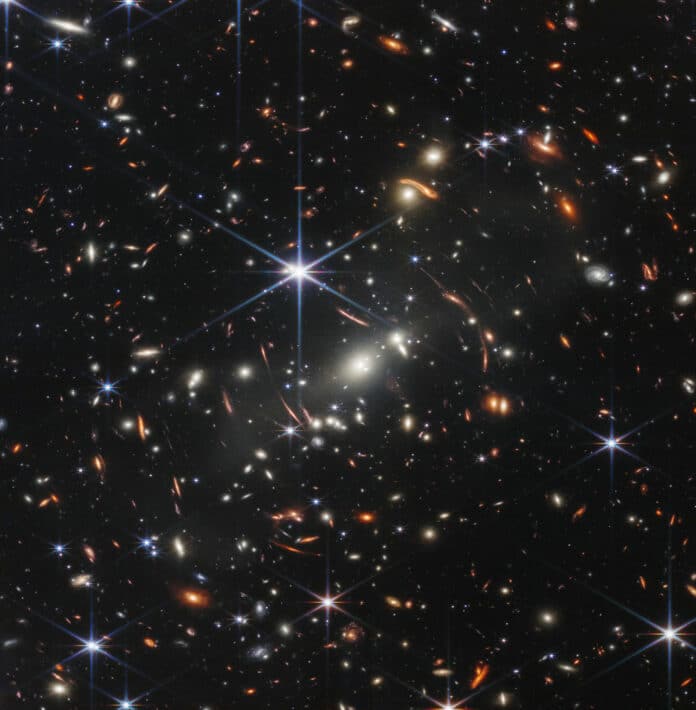The Canadian NIRISS Unbiased Cluster Survey (CANUCS) team discovered the most distant globular clusters ever found using the James Webb Space Telescope (JWST). These dense groups of millions of stars may be relics that contain the first and oldest stars in the universe.
This discovery in Webb’s First Deep Field already provides a detailed look at the earliest phase of star formation, confirming the incredible power of JWST.
The nine billion light-year-away “Sparkler galaxy” was the focus of the exquisitely detailed Webb’s First Deep Field image, said the astronomers. The researchers called these compact objects around this galaxy “sparkles,” which appeared as small yellow dots.
According to the research team, these sparkles might either be new clusters of stars actively developing that were formed three billion years after the Big Bang at the height of star formation or old globular clusters. Globular clusters are old collections of stars from the beginning of a galaxy, providing information about the early stages of its development and expansion.
From their initial analysis of 12 of these compact objects, the researchers determined that five of them are not only globular clusters but among the oldest ones known.
Kartheik G. Iyer, Dunlap Fellow at the Dunlap Institute for Astronomy & Astrophysics at the University of Toronto and co-lead author of the study, said, “Looking at the first images from JWST and discovering old globular clusters around distant galaxies was an incredible moment, one that wasn’t possible with previous Hubble Space Telescope imaging.”
“Since we could observe the sparkles across a range of wavelengths, we could model them and better understand their physical properties, like how old they are and how many stars they contain. We hope the knowledge that globular clusters can be observed from such great distances with JWST will spur further science and searches for similar objects.”
Lamiya Mowla, Dunlap Fellow at the Dunlap Institute for Astronomy & Astrophysics at the University of Toronto and co-lead author of the study, said, “These newly identified clusters were formed close to the first time it was even possible to create stars. Because the Sparkler galaxy is much farther away than our own Milky Way, it is easier to determine the ages of its globular clusters.
“We are observing the Sparkler as it was nine billion years ago, when the universe was only four-and-a-half billion years old, looking at something that happened a long time ago. Think of it as guessing a person’s age based on their appearance—it’s easy to tell the difference between a 5- and 10-year-old, but hard to tell the difference between a 50- and 55-year-old.”
The Sparkler galaxy is special because it is magnified by a factor of 100 due to an effect called gravitational lensing—where the SMACS 0723 galaxy cluster in the foreground distorts what is behind it like a giant magnifying glass. Moreover, gravitational lensing produces three separate images of the Sparkler, allowing astronomers to study the galaxy in greater detail.
CANUCS team lead Chris Willott from the National Research Council’s Herzberg Astronomy, and Astrophysics Research Centre said, “Our study of the Sparkler highlights the tremendous power in combining the unique capabilities of JWST with the natural magnification afforded by gravitational lensing. The team is excited about more discoveries when JWST turns its eye on the CANUCS galaxy clusters next month.”
The researchers combined new data from JWST’s Near-Infrared Camera (NIRCam) with HST archival data. NIRCam detects faint objects using longer and redder wavelengths to observe past what is visible to the human eye and even HST. Both magnifications due to the lensing by the galaxy cluster and the high resolution of JWST made observing compact objects possible.
The Canadian-made Near-Infrared Imager and Slitless Spectrograph (NIRISS) instrument on the JWST confirmed that the objects are old globular clusters because the researchers did not observe oxygen emission lines—emissions with measurable spectra given off by young clusters that are actively forming stars. NIRISS also helped unravel the geometry of the triply lensed images of the Sparkler.
Marcin Sawicki, Canada Research Chair in Astronomy, professor at Saint Mary’s University, and study co-author, said, “JWST’s made-in-Canada NIRISS instrument was vital in helping us understand how the three images of the Sparkler and its globular clusters are connected. Seeing several of the Sparkler’s globular clusters imaged three times made it clear that they are orbiting around the Sparkler galaxy rather than being simply in front of it by chance.”
Journal Reference:
- The Sparkler: Evolved high-redshift globular cluster candidates captured by JWST. The Astrophysical Journal Letters (2022). DOI: 10.3847/2041-8213/ac90ca
